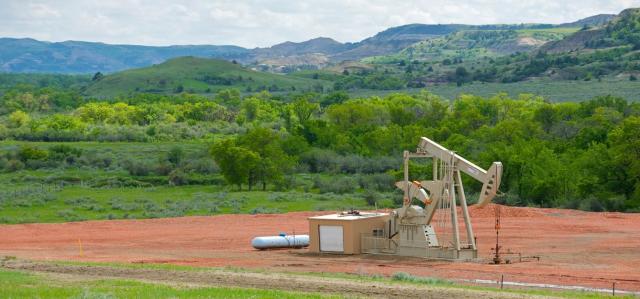
ConocoPhillips expects to produce 70,000 boe/d in the Bakken through 2020. (Source: ConocoPhillips)
If North American oil production were a race, the Permian Basin would, of course, have lapped everyone else in the field long ago. But in this theoretical competition, the Bakken is neck and neck with the Eagle Ford, with each producing about 1.2 MMbbl/d, according to the U.S. Energy Information Administration (EIA). Although the Eagle Ford has higher max production potential, as evidenced by its 1.7 MMbbl/d of output in 2015, the Bakken represents resiliency and predictability; it didn’t quite suffer the valleys other basins did post- 2015, and its production levels are expected to remain at its current pace for the foreseeable future.
Stephen Beck, senior director, upstream, at Stratas Advisors, said he expects the Bakken’s productivity to maintain a 1.2-MMbbl/d production level through 2022 and taper off slightly to 1.1 MMbbl/d through the end of the decade. According to the EIA, the Bakken’s total oil production increased by 12,000 bbl/d between February and March.
Beck explained that the Bakken is a well-harvested asset in which many operators such as Continental Resources leverage their cash flow from the basin to other plays, such as—in Continental’s case—the Midcontinent Stack. The Bakken’s maturity and production characteristics could lead to a growth in consolidation over the next few years, Beck said.
“That cradle along the Missouri River, you have a bit more gas and you have a gas drive that has been at the heart of where most of the [drilling] activity has been,” he said. “As that gets more and more drilled, it only makes sense that the remaining Bakken assets would trade hands into the most capable operators and the operators who have interest in staying there for the longer term.”
Among those committed operators, Beck said, are likely to be Hess and Whiting, with the likes of Continental Resources, EOG Resources and ConocoPhillips among the basin’s leading players.
Continental
According to shaleprofile.com, Continental is the region’s leading producer, having averaged 159,801 bbl/d in January from its 1,597 operating wells, and that amount was up 6% from December 2017 when Continental produced 150,856 bbl/d.
Continental experienced all-time high growth in 2017 in the Bakken, according to a 2018 investor presentation, with production up 58% over fourth quarter 2016. As with most other unconventional operators, the increased production rates are a result of optimized completion designs, the company reported.
Production from its 134 optimized completions resulted in a 12.5% increase over the first 300 days of production compared to the company’s 1,100 Mboe type curve—a result of 270,000 boe for its optimized wells compared to 240,000 boe in its type curve.

Hess
Hess ramped up its Bakken production at the tail end of 2017 and into this year, having produced 85,491 bbl/d from 1,375 wells in October 2017, an amount that increased 13% in January to 96,639 bbl/d from 1,403 wells. The company’s total boe production in 2017 was 105,000 boe/d, said CEO John Hess during the company’s fourth-quarter 2017 investor call.
Hess said the company intends to grow its production in the Bakken to 175,000 boe/d by 2021.
“Through the application of geosteering, optimized spacing, higher stage counts and proppant loading, we have increased our well productivity by approximately 50% over the last two years,” he said. “These improvements, together with our low drilling and completion costs, have enabled us to generate returns that are competitive with any shale play in the United States.”
He added that Hess is forecasted to average between 115,000 and 120,000 boe/d this year.
During the investor call, Hess President and COO Gregory Hill said the company executed pilots of 60-stage completions with increased proppant loading, which resulted in a 10% to 15% uplift in IP180.
“As a result, we’ve increased our EUR from our Bakken acreage to 2 billion barrels of oil equivalent from our previous 1.7 billion barrels of oil equivalent,” Hill said.
EOG Resources
David Trice, executive vice president of E&P at EOG Resources, said during the company’s fourth-quarter 2017 investor call that EOG’s focus in the Bakken last year was on drawing down its inventory of legacy drilled but uncompleted wells (DUCs), which he said were not drilled with the company’s recent precision targeting techniques.
“Once we completed our inventory of DUCs, we completed a few fantastic wells in both the Bakken and the Three Forks targets,” Trice said.
EOG’s Bakken production, however, receded last year from its June production peak of 70,115 bbl/d, according to shaleprofile.com. By January EOG was producing 46,344 bbl/d, a 34% decline.
EOG plans to complete about 20 wells this year in the Bakken Core and Antelope extension compared to the 35 it completed in 2017. Its Bakken/Three Forks completions feature 2,560-m (8,400-ft) laterals with 198-m (650-ft) spacing.
“We’ll also drill a number of step-out wells in the Bakken Lite and other areas to continue testing and redefining our latest precision targeting and advanced completions outside our core operating areas,” according to Trice.
Over the past two years, EOG has reduced well costs by more than one-third, down to $4.6 million per well last year, he said.
“We expect to continue lowering costs through a recently implemented seasonal drilling and completion program,” Trice said. “Wells are drilled year-round, then completed mostly during the summer. This program will eliminate the additional expense incurred by handling water during the freezing winter months and dealing with road restrictions during breakup.”
ConocoPhillips
ConocoPhillips is applying its own technologyenhanced completion optimizations across the Eagle Ford, Delaware and Bakken resource plays. According to a 2018 investor presentation, the company is expecting to maintain a production level of 70,000 boe/d through 2020.
According to shaleprofile.com, ConocoPhillips’ production in the Bakken has steadily increased since December 2016 from 49,186 bbl/d to 79,453 bbl/d in January 2018.
Whiting
Whiting is North Dakota’s second leading producer, behind Continental Resources, producing 103,897 bbl/d in January. The company reported in its fourthquarter 2017 investor presentation that it expects to increase its overall boe production compared to last year by 9% to 128,400 boe/d. To improve recoveries, Whiting has tweaked its completion designs in the Williston Basin over the past eight years to its Generation 4 completions. According to a 2018 company investor presentation, its Generation 1 completions, which the company ran from 2010 to 2012, featured 240 lb/ft of proppant, 115.8-m (380-ft) stage spacings and 115.8-m cluster spacings, along with a ball-and-sleeve and packer completion.
In 2018 Whiting will apply completions that feature 600 lb/ft to 1,200 lb/ft of proppant, 60.9-m to 91.4-m (200-ft to 300-ft) stage spacings and 9.1-m to 15.2-m (30-ft to 50-ft) cluster spacings, with cemented liner plug and perf. The company expects well costs to range from $6.5 million to $7.1 million, according to the investor presentation.
Recommended Reading
Biden Administration Criticized for Limits to Arctic Oil, Gas Drilling
2024-04-19 - The Bureau of Land Management is limiting new oil and gas leasing in the Arctic and also shut down a road proposal for industrial mining purposes.
Tax Credit’s Silence on Blue Hydrogen Adds Uncertainty
2024-01-31 - Proposed rules for the 45V hydrogen production tax credit leave blue hydrogen up in the air, but producers planning to use natural gas with carbon capture and storage have options.
From Satellites to Regulators, Everyone is Snooping on Oil, Gas
2024-04-10 - From methane taxes to an environmental group’s satellite trained on oil and gas emissions, producers face intense scrutiny, even if the watchers aren’t necessarily interested in solving the problem.
Hirs: LNG Plan is a Global Fail
2024-03-13 - Only by expanding U.S. LNG output can we provide the certainty that customers require to build new gas power plants, says Ed Hirs.
CERAWeek: Energy Secretary Defends LNG Pause Amid Industry Outcry
2024-03-18 - U.S. Energy Secretary Jennifer Granholm said she expects the review of LNG exports to be in the “rearview mirror” by next year.





